Evolutional Rules of Regional Groundwater System
DISCUSS ON ENRICHMENT MECHANISM OF GROUNDWATER IN THE REPRESENTATIVE WATER-SHORTAGE AREAS OF THE NORTHWESTERN CHINA
Jianping Sun1,2 , Yumei Wei1,2, Hongtao Wu2
1. Environmental Studies Faculty,
2.Institute
of Hydrogeology and Engineering
Geology Techniques CGS, Baoding 071051,
Abstract: The 5 provinces in the northwest of China including Shanxi, Gansu ,Ningxia ,Qinghai ,Xinjiang and the western Inner Mongolia Autonomous province are the most representative arid and semiarid areas, which has an area of 330×104 km2. It is water-shortage, that not only restricts the condition of people's life,but also affects the economical development in these regions. In this paper, according to the results of hydrogeology investigation and experiences summed up by our predecessors, we discuss on the enrichment mechanism and exploitation pattern of groundwater in the representative water-shortage areas of the northwest. We try to offer the technical guide on hydrogeology investigation and groundwater exploration in similar regions.
Key words: northwestern
1 Introduction
The 5 provinces in the northwest of China including Shanxi ,Gansu, Ningxia, Qinghai, Xinjiang and the western Inner Mongolia Autonomous province are the most representative arid and semiarid area, which has an area of 330×104 km2. It is water-shortage, that not only restricts the condition of people's life,but also affects the economical development in these regions. In order to solve local drinking water problem, China Geology Survey has implemented groundwater supply demonstration project. According to the enrichment mechanism and exploitation of groundwater, we try to offer the technical guide on hydrogeology investigation in water-shortage regions.
2 Enrichment Pattern of Groundwater in front of Mountains Around Inland Basin
The northwestern inland basin is surrounded by a series of great fold mountains, the difference of the up-and-down movements between the basin and the mountain and the region deep geological structures following strike of the mountain not only control the Quaternary deposit thickness in the basin, but also greatly affect the form, distribution, enrichment and movement of groundwater in the Quaternary aquifer. Concealed break, there are four water storage patterns formed by the piedmont concealed break, the uplifted bedrock and the Q4 layer (table 1). [3]
Table 1 Storage pattern of groundwater in front of mountains around Inland Basin
|
Number |
Pattern |
Instruction |
|
1 |
Uplifted bedrock |
It is composed of uplifted fold and layer of Q4 |
|
2 |
Imbricate |
It is composed of parallel "imbricate" concealed fault and layer of Q4 |
|
3 |
Thrust ress-skew fault |
Thickness of Q4 has a great change |
|
4 |
Fault trough |
It is composed of hills and layer of Q4 in block |
2.1 Water storage pattern of uplifted bedrock
In the
margins of the southern
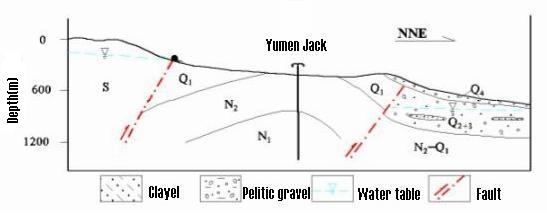
Fig.1 Controlling water pattern diagram of fragmantary rock waterproofing and fault structure in piedmont of inland basin
The runoff of the bedrock crevice water is held up by the hanger of the fault belt, it brings a series of hydrogeological phenomenons, such as the groundwater table increasing, the wetland, the soil solidification, the spring overflow, the grass tree growth in the individual region; In the connected region of hilly country and corridor plain,the groundwater table changes suddenly, it forms 100-200m or deeper "waterfall" in the connected region of hilly country and corridor plain. The water barrier is composed of the fragmentary rock of the cretaceous system and the Tertiary system between the old bedrock mountain and the Q4 plain . The mountainous surface water and the bedrock crevice water recharge basin only by deep ditch and ditch underflow. Therefore, groundwater resources are deficient in the piedmont plain which has no river or bigger run-off ditch passing through. Because of the fault waterproofing, it forms hydraulic drop in the bottom of fault, the groundwater buried depth is generally more than 200m. In the transition zone of monolayer to multi-layer framework, the groundwater buried depth is relatively shallower in abrupt and inclining plain, which is generally less than 100m, and the water quality is better, so it is the ideal region to concentrative water supply. In the fold hill country of the hanger, there are certain thickness Q4 deposits in the depression and valley, the groundwater buried depth is shallow near the hanger, it is suitable for small scale concentrative water supply.
2.2 Water storage pattern of " Imbricate"
In the south of Zhangye city, which lies in the Zhangye basin in Gansu Corridor, the Cenozoic "imbricate" faults have the width of 2-6km under the Q4 layer(Fig.2). These faults and the Q4 layer constitute water storage pattern of "imbricate". On the two sides of fault bedrocks are obviously step-shaped, (thickness change of Q4 layer) the change of the Q4 layer thickness is sudden, the thickness of the Q4 layer is smallest near the upper plate of fault, but becomes large in the lower plate of fault, the difference is more than a hundred meters . The thickness of the Q4 loose layer is small in the steps of the fault near the mountain, the surface river system is not development, the aquifer only distributes near the river (valley). In the step-shaped fault, the fault prevents water from flowing and the buried depth of the Q4 layer shows a sudden change, so depth of groundwater is obviously lower in the upper plate of fault than the lower plate, it forms "the underground waterfall". The D-value of groundwater table is generally 4-20m in the steps of the fault near the mountain, and it reaches 100m away from mountain, even more than 200m. Therefore, the take-wells are supposed to arrange in the upper break zone or the land sector that has a certain distance to the lower plate of fault.
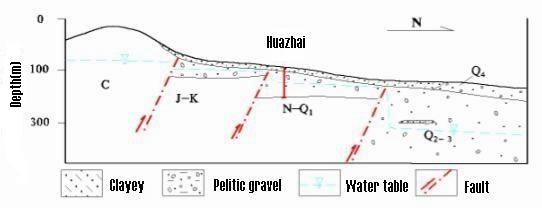
Fig.2 Controlling water pattern diagram of thrust concealed "imbriciate" fault structure in piedmont of inland basin
2.3 Water storage pattern of thrust press-skew fault
Mountainous bedrock of northwestern inland basin edge and plain of the Q4 basin are generally contacted with some large-scale thrust press-skew concealed the fault. In Xidong zone of Zhangye basin ,Gansu Corridor, former mountainous Cretaceous bedrock connects directly with the piedmont plain, there is not waterproof barrier that is composed of Cretaceous and Tertiary fragmentary rock at central section, besides surface water runoff, the mountainous bedrock crevice groundwater also has the certain lateral recharge to the basin. In addition, there are generally the multiple faulting faults in the piedmont bedrock, it has function of water storage, the bedrock crevice groundwater overflow in piedmont fault zone, and after the short runoff infiltrates vanishes in the basin. This type may divide into two kinds of subclasses: The first kind of subclass (Fig. 3) with thrust press-skew concealed fault developing forms the fault mylonite with 100-400m width, the function of this fault is primarily waterproofing, its partial land sector has the function of guiding and storaging water; On the upper of fault, it appears non-hydrgeological phenomenon, but there is a certain quantity of groundwater in the high mylonite fault zone, also related to the mountainous water system developing; In the connected region of the fault and the plain, the water table changes suddenly, it forms " waterfall" with 120-180m, the buried depth of water is generally more than 250m in the lower plate of the fault, the cost of groundwater exploration is even higher. In the fault mylonite crush belt, it has a function of guiding and storaging water, the mountainous groundwater recharges the plain by not only dives of ditch and infiltration, but also by the fault zone, the buried depth of water is relatively shallow. This kind
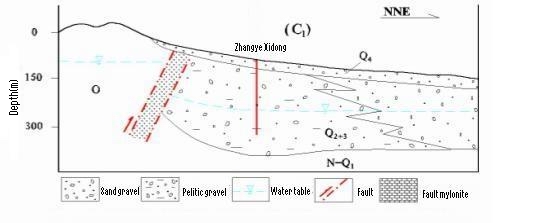
Fig.3 Controlling water pattern diagram of thrust concealed fault mylonite waterproof structure in piedmont of inland basin
mainly distributes from west of HeiRiver to piedmont of LiyuanRiver in Zhangye Basin of HeiRiver region. The second kind of subclasses is thrust press-skew concealed fault with no mylonite (Fig. 4), the mountainous bedrock crevice water is cut off by the fault, it has not directly hydraulic relation to the plain, the mountainous groundwater recharges the plain by underflow in the the ditch (valley) and laterally runoff in the upper plate slope wash aquifer of the fault; Along the upper plate of fault, it often appears linear springs, wetland ,etc; In the lower plate of fault , the groundwater table is deep, it forms more than 100m height of " waterfall ". The depth of groundwater in the Piedmont Q4 is generally more than 200m, the quantity and quality of groundwater is good, but the cost of draft water is even higher. For low-lying and medium and small scale ditch (valley) in the upper plate of fault, if the Q4 thickness has the guarantee, the depth of groundwater is generally less than 100m, the water volume is limited, it is suitable for the small scale centrative water supply. This subclass mainly distributes in the Zhangye Longwangmiao(Gansu Corridor), Jinfusi(Jiuquan), qianfudong (west of Dunhuang). Other areas are the north Tian mountain east foothill, Chaiwobao basin partial land sector, the piedmont of Talimu basin Dongqueletage.
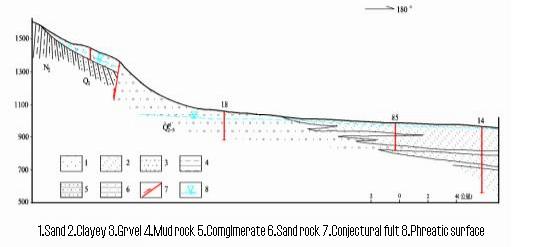
Fig.4 Controlling water pattern diagram of thrust concealed fault structure in piedmont of inland basin
2.4 Water storage pattern of fault trough
The Cenozoic layer under the piedmont Q4 plain extends to the centre of basin, and runs out of the Q4 plain through the overthrust structure, it stands up plain region, forms height of 100-200m hills swell zone, on the two sides of the hill simultaneously have secondarily concealed fault, swell and concealed fault which separate the basin (Fig. 5), but it is not the seal closed mountainous basin, named fault trough. The Q4 thickness of basins on the two sides is different, the groundwater runoff is from piedmont to fore-desert basin, because of the swell of clay series rock layer waterproofing, the water table becomes shallow near the swell zone, in the partial land sector, it often forms linear spring , the hydraulic relation in two basins is close, besides the partial groundwater overflow and form spring, the most discharge circle edge of swell
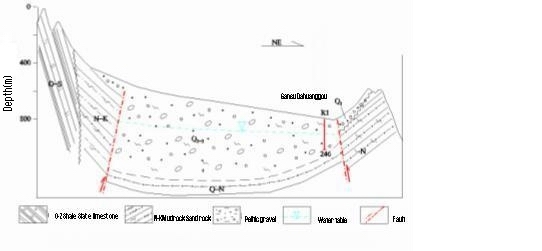
Fig.5 Controlling water pattern diagram of Thrtiary swell structure in piedmont of inland basin
through the groundwater runoff, it forms “waterfall” in basin that lies another side of swell. The zone that depth of groundwater is shallow on the edge of swell structure is served as water supply resource. The typical swell structures have Wenshu mountain (Sunan county), Yonggu (Minle county), Hong mountain (Yongchang county) etc.
3 Enrichment Mechanism of Fragmentary Rock
Groundwater in the Central Section of Xining and
In the Eastern Qinghai and center
3.1 Carbonate rocks monocline water storage structure
In the southern Daban hill of Northern Xining basin and the piedmont hills, proterozoic dolomite, the marbles, the Cretaceous and Tertiary fragmentary rocks had develped, they form a series of carbonate rocks monocline water storage structure by geologic tectonism, (Fig. 6).
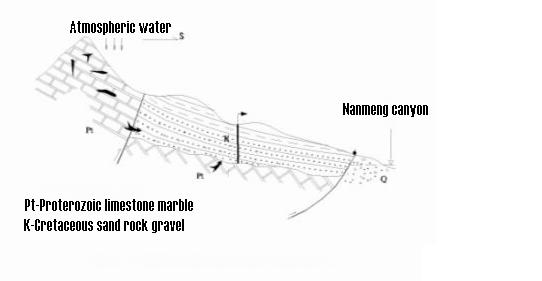
Fig.6 Diagram of Cretaeous fragmantary rock monocline water storage
3.2 Cretaceous horst-graben water storage structure
The
development of the north-east tension-shear fault and east-west compress-shear
fault is in center fragmentary rock
3.3 Cretaceous fragmentary rock concealed fault crush belt water storage structure
In the
HuangShui
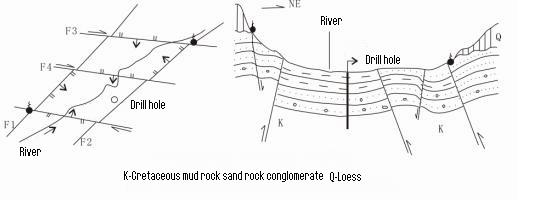
Fig.7 Diagram of Qingdong Cretaeous fragmantary rock Leiqian water storage
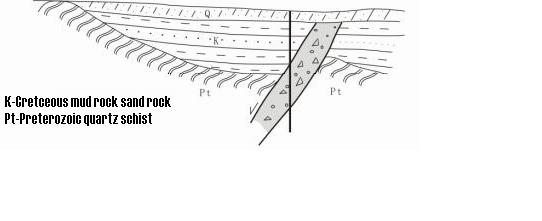
Fig.8 Diagram of Cretaeous fragmantary rock concealed fault crush belt water storage
4 conclusions
Northwestern inland basin scopes are broad, its conditions are respectively different, enrichment mechanisms of groundwater are complicated, so we must comprehensively investigate geological and
hydrological conditions, study on its enrichment mechanisms of groundwater and provide the theories for the groundwater exploration.
Main reference
[1] China
Geological Survey edits. Groundwater Exploration in the Semiarid Areas in
[2] China
Geological Survey edits. Groundwater Exploration in the Semiarid Areas in
[3] China Geological
Survey edits. Groundwater Exploration for Drinking in the Water-shortage Areas
of the Weasten China (1)




